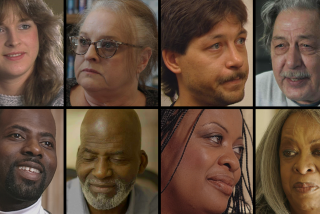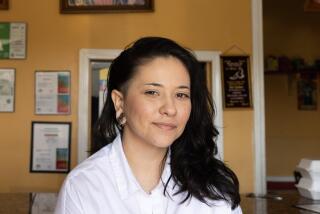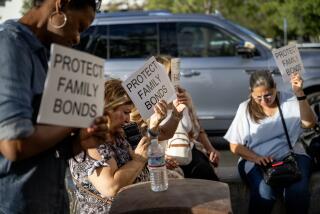Summer Ritual of Family Reunion Thrives in Age of Separation : Tradition: For many, such gatherings are a chance to touch base with the past and become acquainted with the future.
- Share via
Al and Minerva Trimboli had eight children who grew up to have 23 sons and daughters of their own. And as the family tree grew, its branches spread out to new lives in new places.
“You’ve got to go where the work is,” said Greg Trimboli, the father of two young daughters. “But it’s also important to come home to family and those bonds, especially when times are tough.”
Family reunions uphold ritual amid perpetual change, continuity when nothing is certain. For many, such gatherings are a yearly chance to touch base with the past and become acquainted with the future.
The Trimboli clan’s reunion takes place each July in Ludlow, on Vermont’s Okemo Mountain. They call it the ‘Boli Bash--a party for 70 or so kinfolk who come from Colorado, Indiana, New York, all over.
“There’s volleyball and shuffleboard, basketball, pool and softball,” said Trimboli, 40, who hosts the reunion with his wife. “We’ve got three or four acres under the mountain. There are streams, and the kids catch snakes.”
The heart of the weekend’s events is the chance simply to sit and talk, to renew old bonds and perhaps forge new ones. This is the glue not only for the Trimbolis, but for thousands of families who will gather for reunions this summer.
“The tradition has become a kind of symbol of security and a lost, romanticized past families can make happen one day a year,” said Gwen Kennedy Neville, a cultural anthropologist at Southwestern University in Georgetown, Tex., and author of “Kinship and Pilgrimage.”
“For a long time, we tended to think of reunions as old-fashioned,” Neville said, “but in the modern world, they are an increasingly important way of being part of something while also pursuing our individual interests.”
The United States is a nation of wanderers, built in part by people who set out young to seek opportunity and fortune far from home. About 44 million Americans, or 18% of the population, move each year, according to the Census Bureau. Compare that to Ireland, where only about 5% of the population moves annually.
Vance Packard, author of “A Nation of Strangers,” said: “High mobility is a serious problem in our society. It’s a part of our national neuroses. People are so lonely in many parts of the country that they welcome junk mail.”
It is precisely that isolation that compels many far-flung relatives to interrupt busy routines for a few days each year and make a pilgrimage back to an old family homestead, camp meeting ground, posh resort or familiar church hall.
“It’s just that time of year when you know you’re really going home,” said Amanda Dargan, 41, who left her large, rural South Carolina farm family to work in Philadelphia, Washington, D.C., Canada and, finally, New York.
Dargan and her husband, Steve Zeitlin, are folk arts scholars who take special care to stress tradition in raising their two young children.
Like so many young couples, they have no real roots in their adopted community. Both must work double time to create and maintain a sense of ritual at home while keeping up at work.
This year, for the first time, Amanda missed her family’s annual Fourth of July reunion. She missed the slide show, swimming relays, horseshoes, storytelling, picnics and tubing on Black Creek.
“We were in the middle of a move and couldn’t get away,” she said. “And I was sorry about that. It’s my anchor . . . and a great thing for my children.”
So little is sure for so many kids. Divorce and frequent moves have separated families. Grandparents, and sometimes even a parent, may be far away; cousins, aunts and uncles may be strangers.
“The family structure has changed so much, and it’s more than just a passing thing,” said Alex Thomas, a psychologist at Miami University in Oxford, Ohio. “When there is so much disconnectedness, when it’s so easy to lose a sense of belonging, it’s important for youngsters to latch onto something inviolable.”
Family reunions can give tremendous comfort in a fragmented world, but they involve hard work, organization and facing a sometimes trying reality: You can’t pick your relatives.
“Tempers can flare, that’s for sure,” said Joyce Rosenbusch of Florence, Tex. “One time, it was trying to decide where to have it; another time it was a movement to do away with the Sunday morning devotional; another time it was whether the people coming a distance should bring food or not.”
Still, such squabbles generally are forgotten. “Because in the end,” Rosenbusch said, “it’s a gathering of all your kin and you’re there to have a good time.”
Eating the food that grandmother cooked is integral to the ritual. For the Rosenbusch clan, the Sunday covered-dish luncheon is a high point: pork chops and rice casserole, potato salad and baked beans, banana pudding, chocolate pie and peach cobbler.
Food also is important to the Howard family’s gatherings in Waco, Tex., but theirs is a different menu: hot-water corn bread, mustard greens, black-eyed peas and ham hocks are served up with their stories of a proud heritage.
“My father always taught me to take care of the family, to keep it together,” said Willie Mae Howard Sterling who, at 72, is among the honored elders. “Sharing our history makes the family stronger.”
Her husband was killed and her home destroyed by a fire just a few weeks before the family’s annual gathering in July, but she was there, as always, under a pecan tree at the white-shingled homestead built so long ago that no one remembers when.
“I don’t know if it’s the same for black and white families, but history is very important to us,” said LaMarriol Smith, one of about 300 relatives who attend the Howard reunions.
“There are a lot of broken structures now--not as many men in the family, a lot of single mothers,” said Smith, 26. “It’s important that we have a tie, a connection with our roots not only for the history of where we’re from, but also to give the younger ones a direction to go in.”
Reunions are a more businesslike affair for the Eskridge family. Some would call theirs a blue-blooded clan. Tom Steptoe, a circuit judge in West Virginia, simply calls it “an old Virginia family.”
Founded in the 1930s, the Eskridge Family Assn. is more about maintaining ties that stretch all the way back to George Washington and Robert E. Lee than about chatting over barbecue.
“We don’t have a picnic. We have a meeting, then go somewhere for a luncheon,” said Steptoe, the group’s president and, at 40, one of the younger members. “To be quite frank, we don’t really have much chance to mingle.”
The Eskridge group is more concerned with electing officers, saving heirlooms, lobbying for legal protection of historic properties and allotting funds to various heritage preservation projects.
This year’s reunion at the Stratford Hall Plantation near Montross, Va., was, as usual, a fairly sober event. Yet Steptoe said he finds something spiritual and satisfying in the ritual gathering.
“I got newsletters from the organization for years, but when I was in college, it just didn’t interest me at all,” said Steptoe, who went to his first meeting in 1981 and today attends with his daughter.
“I discovered eventually that it’s important to look back through time and see continuity, to realize that we’re not just people that come into being, live a certain number of years and die,” he said.
“Everybody wants to know where they come from, feel they belong to more than a city or a town.”


